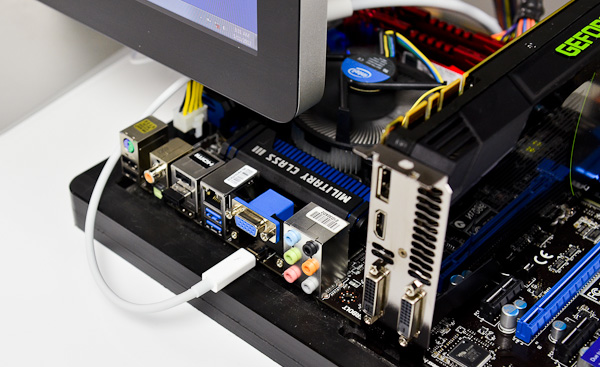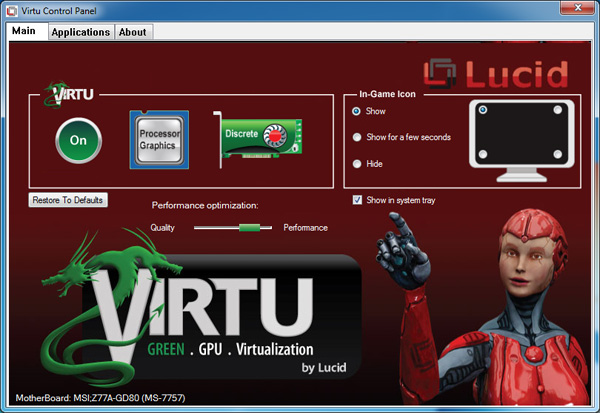A First Look at Thunderbolt on Windows with MSI's Z77A-GD80
by Anand Lal Shimpi on May 11, 2012 1:32 PM EST- Posted in
- Motherboards
- CPUs
- Intel
- MSI
- Thunderbolt
The Thunderbolt Display
The first test was hooking up Apple's Thunderbolt Display, the only Thunderbolt display device available on the market today. Although I shouldn't have been, I was a bit surprised when the display just worked. Intel's HD 4000 drove the 2560 x 1440 panel just fine and there weren't any funny issues displaying the lower res UEFI setup mode.
Despite Ivy Bridge being able to drive three independent displays, I was only able to simultaneously output to two connected displays on the GD80. All combinations of two worked however (TB + HDMI, TB + VGA, VGA + HDMI).
Once in Windows, the Thunderbolt Display's integrated GigE, Firewire and other controllers started popping up. Unfortunately Apple doesn't offer a direct download package for Thunderbolt Display drivers. You can either hunt down the controllers/drivers on their own, or you can build a Windows Support (driver) package using a Mac and the Boot Camp Assistant. I'd much rather Apple just offer an easy route for non-Mac Windows users to take advantage of the Thunderbolt Display as it's the only TB display on the market, but I can understand the lack of motivation there.
With the Boot Camp drivers installed, I got working GigE and Firewire 800. The Thunderbolt Display's integrated USB hub gave me issues however. Anything I plugged into it would either partially work (e.g. my mouse was detected but moving the cursor was far from smooth) or not work at all (e.g. my attached USB keyboard never worked). The other issue with the Thunderbolt Display is you get no brightness control, which can be a problem given how bright the panel gets. I've seen reports of people getting brightness control working via software tools but the solutions don't seem permanent.
Apple's Thunderbolt Display definitely works, but Windows users will likely want to wait for a Thunderbolt display that is built specifically with Windows in mind.
Virtu and Thunderbolt: It Works
From a software perspective, Thunderbolt is treated just like another display output driven by Intel's processor graphics. I installed a GeForce GTX 680 along with Lucid's Virtu GPU virtualization software to see if I could use the 680 for gaming but drive the display using Intel's processor graphics and the Thunderbolt port. The setup worked flawlessly.
Virtu recognized the configuration immediately once I had NVIDIA's drivers installed, and I was able to run the 680 headless - using only the Thunderbolt port to drive the external display. Intel's HD 4000 powered things in Windows, while the 680 kicked in for games.













98 Comments
View All Comments
repoman27 - Saturday, May 12, 2012 - link
Overprovisioning is usually not a problem. What you have here is oversubscription, which definitely can be. The only chips on this motherboard that seem to be using the 8 PCIe lanes off of the PCH are the FireWire and SATA controllers, which use one apiece, and the Thunderbolt controller, which seems to be a 4 channel Cactus Ridge chip which uses four lanes. The audio chip does not connect to the PCH via PCIe, nor does the PHY chip for the Intel NIC, as far as I know. If they had just gone with 2 less PCIe x1 slots, they wouldn't have had any contention issues.It's odd that MSI would use a 4 channel Thunderbolt controller and only provide a single Thunderbolt port. The PCIe throughput figures definitely point to this being the 4 channel version though. If it can drive 2 Thunderbolt displays, then it definitely is, and I'm guessing that the reason why only two of the display outputs work at the same time is because 2 of the 3 video signals from the IGP are going to the Thunderbolt controller.
Death666Angel - Monday, May 14, 2012 - link
But then VGA+HDMI would not work, would it?repoman27 - Monday, May 14, 2012 - link
Nope. I realized that after I posted, but then I hurt my brain trying to figure out how the display signals were actually routed from the PCH in order to cause this behavior.Jamiex - Sunday, May 13, 2012 - link
could you get as high framerate when playing game through thunderbolt with the Lucid's Virtu GPU virtualization and an external GPU as you would when connecting directly to the external GPU? I don't fully understand how it works.Death666Angel - Monday, May 14, 2012 - link
Pretty much, you lose a few percentage points going through the iGPU frame buffer. The way it works is that the GTX680 (or any dGPU) renders the frame and has it in its frame buffer. The Virtu software then copies said frame buffer over to the iGPU frame buffer and that iGPU has a direct connection to TB/HDMI/VGA off the mainboard. The act of copying the frame buffers has some overhead, but performance in the last review I saw of it was 97% to 100%.gtm - Monday, May 14, 2012 - link
I find Thunderbolt interesting for the ability to put one big and loud pc in one room, and get all I/O in another room, saving noise, space and cable mess.But is it possible to wake an hibernating PC using for example an USB-Keyboard connected to a thunderbolt display?
Death666Angel - Monday, May 14, 2012 - link
3m cable length for the copper version doesn't seem like enough for that usage case though. :-)repoman27 - Monday, May 14, 2012 - link
That's why you need to get one of these:http://www.macworld.com/article/1166542/optical_ca...
gtm - Tuesday, May 15, 2012 - link
Yes, I was thinking of those. Maybe even with a little more bandwidth, so that a Quad-HD display can be plugged, when they become affordable.But running upstairs to resume from suspend is no fun.
roaminggnome - Tuesday, May 15, 2012 - link
Did you happen to test to see if the Display supported Audio IN/Out or Video over the built in speakers/iSight?